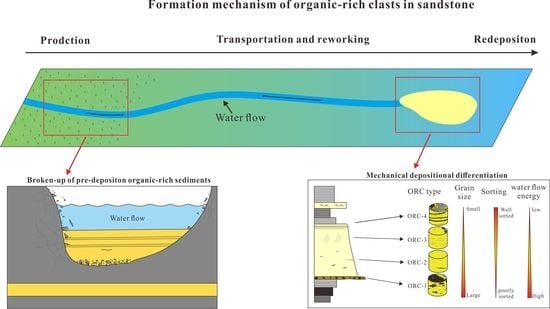Occurrence, Classification and Formation Mechanisms of the Organic-Rich Clasts in the Upper Paleozoic Coal-Bearing Tight Sandstone, Northeastern Margin of the Ordos Basin, China
Abstract
1. Introduction
2. Geological Setting
3. Methodology
4. Results
4.1. Facies Association I
Description
Interpretation
4.2. Facies Association II
Description
Interpretation
4.3. Facies Association III
Description
Interpretation
4.4. Facies Association IV
Description
Interpretation
4.5. Facies Association V
Description
Interpretation
5. Discussion
5.1. Occurrence and Classification
5.2. Formation Mechanism
6. Conclusions
Author Contributions
Funding
Acknowledgments
Conflicts of Interest
References
- Knight, J. Morphology and palaeoenvironmental interpretation of deformed soft-sediment clasts: Examples from with Late Pleistocene glacial outwash, Tempo Valley, Northern Ireland. Sediment. Geol. 1999, 128, 293–306. [Google Scholar] [CrossRef]
- Knight, J. Significance of soft-sediment clasts in glacial outwash, Puget Sound, USA. Sediment. Geol. 2009, 220, 126–133. [Google Scholar] [CrossRef]
- Haas, W. Formation of Clay Balls. J. Geol. 1927, 35, 150–157. [Google Scholar] [CrossRef]
- Karcz, I. Mud pebbles in a flash floods environment. J. Sediment. Res. 1969, 39, 333–337. [Google Scholar] [CrossRef]
- Kneller, B.; Branney, M. Sustained high-density turbidity currents and the deposition of thick massive sands. Sedimentology 1995, 42, 607–616. [Google Scholar] [CrossRef]
- Allen, J. Reworking of muddy intertidal sediments in the severn estuary, Southwestern U.K.-A preliminary survey. Sediment. Geol. 1987, 50, 1–23. [Google Scholar] [CrossRef]
- Goldschmidt, P. Armoured and unarmoured till balls from the Greenland Sea floor. Mar. Geol. 1994, 121, 121–128. [Google Scholar] [CrossRef]
- Selby, I.; Evans, N. Origins of mud clasts and suspensions on the seabed in Hong Kong. Cont. Shelf Res. 1997, 17, 57–78. [Google Scholar] [CrossRef]
- Knight, J. Processes of soft-sediment clast formation in the intertidal zone. Sediment. Geol. 2005, 181, 207–214. [Google Scholar] [CrossRef]
- Southern, S.; Patacci, M.; Felletti, F.; McCaffrey, W. Influence of flow containment and substrate entrainment upon sandy hybrid event beds containing a co-genetic mud-clast-rich division. Sediment. Geol. 2015, 321, 105–122. [Google Scholar] [CrossRef]
- Gao, Z.; Zhou, C.; Feng, J.; Wu, H.; Li, W. Mechanism and sedimentary environment of the muddy gravel concomitant with thick layer sandstone of Cretaceous in Kuqa depression. Acta Petrol. Sin. 2016, 37, 996–1010. (In Chinese) [Google Scholar] [CrossRef]
- Li, S.; Li, S.; Shan, X.; Gong, C.; Yu, X. Classification, formation, and transport mechanisms of mud clasts. Int. Geol. Rev. 2017, 59, 1–12. [Google Scholar] [CrossRef]
- Bell, H. Armored Mud Balls: Their Origin, Properties, and Role in Sedimentation. J. Geol. 1940, 48, 1–31. [Google Scholar] [CrossRef]
- Dickas, A.; Lunking, W. The origin and destruction of armored mud balls in a fresh-water lacustrine environment, Lake Superior. J. Sediment. Res. 1968, 38, 1366–1370. [Google Scholar] [CrossRef]
- Little, R. Lithified Armored Mud Balls of the Lower Jurassic Turners Falls Sandstone, North-Central Massachusetts. J. Geol. 1982, 90, 203–207. [Google Scholar] [CrossRef]
- Diffendal, R. Armored Mud Balls and Friable Sand Megaclasts from a Complex Early Pleistocene Alluvial Fill, Southwestern Morrill County, Nebraska. J. Geol. 1984, 92, 325–330. [Google Scholar] [CrossRef]
- Mather, A.; Stokes, M.; Pirrie, D.; Hartley, R. Generation, transport and preservation of armoured mudballs in an ephemeral gully system. Geomorphology 2008, 100, 104–119. [Google Scholar] [CrossRef]
- Wani, H.; Dar, S.; Mondal, M. Occurrence of Unusual Unarmored, Unlithified Fossil Mud Balls in Plio-Pleistocene Lacustrine Sediments, Kashmir, India. J. Geol. 2017, 125, 479–486. [Google Scholar] [CrossRef]
- Ghandour, I.; Al-Washmi, H.; Haredy, R. Gravel-Sized Mud Clasts on an Arid Microtidal Sandy Beach: Example from the Northeastern Red Sea, South Al-Wajh, Saudi Arabia. J. Coastal Res. 2013, 291, 110–117. [Google Scholar] [CrossRef]
- Henares, S.; Arribas, J.; Cultrone, G.; Viseras, C. Muddy and dolomitic rip-up clasts in Triassic fluvial sandstones: Origin and impact on potential reservoir properties (Argana Basin, Morocco). Sediment. Geol. 2016, 339, 218–233. [Google Scholar] [CrossRef]
- Allen, J. Sedimentary Structures, their Character and Physical Basis; Elsevier: Amsterdam, The Netherlands, 1982. [Google Scholar]
- Kortekaas, S.; Dawson, A. Distinguishing tsunami and storm deposits: An example from Martinhal, SW Portugal. Sediment. Geol. 2007, 200, 208–221. [Google Scholar] [CrossRef]
- Goff, J.; Chagué-Goff, C.; Nichol, S.; Jaffe, B.; Dominey-Howes, D. Progress in palaeotsunami research. Sediment. Geol. 2012, 243–244, 70–88. [Google Scholar] [CrossRef]
- Gibbard, P.; Boreham, S.; Roe, H.; Burger, A. Middle Pleistocene lacustrine deposits in eastern Essex, England and their paleogeographical implications. J. Quat. Sci. 2015, 11, 281–298. [Google Scholar] [CrossRef]
- Ishizawa, T.; Goto, K.; Yokoyama, Y.; Miyairi, Y.; Sawada, C.; Takada, K. Reducing the age range of tsunami deposits by, 14 C dating of rip-up clasts. Sediment. Geol. 2018, 364, 334–341. [Google Scholar] [CrossRef]
- Plint, A. Slump blocks, intraformational conglomerates and associated erosional structures in Pennsylvanian fluvial strata of eastern Canada. Sedimentology 1986, 33, 387–399. [Google Scholar] [CrossRef]
- Poll, H.; Patel, I. Slump blocks, intraformational conglomerates and associated erosional structures in Pennsylvanian fluvial strata of eastern Canada. Sedimentology 1989, 36, 137–145. [Google Scholar] [CrossRef]
- Gibling, M.; Tandon, S. Erosional marks on consolidated banks and slump blocks in the Rupen River, north-west India. Sedimentology 1997, 44, 339–348. [Google Scholar] [CrossRef]
- Smith, N. Flume experiments on the durability of mud clasts. J. Sediment. Res. 1972, 42, 378–383. [Google Scholar] [CrossRef]
- Woźniak, P.; Pisarska-JamroźY, M. Debris flows with soft-sediment clasts in a Pleistocene glaciolacustrine fan (Gdańsk Bay, Poland). Catena 2018, 165, 178–191. [Google Scholar] [CrossRef]
- Petrascheck, W. Das Vorkommen von SteinkohlengerIllen in einen Karbonsandstein. Verh. Kais. Königlich Geol. Reichsanst. 1909, 16, 380–386. (In German) [Google Scholar]
- Brune, A. Einlagerungen fremder Gesteine in Steinkohlenflo¨tzen unter besonderer Berfcksichtigung Ausffllung von Erosionhohlra¨umen. Glfckauf 1930, 66, 1157–1165. (In German) [Google Scholar]
- Cross, A. The geology of Pittsburgh coal: Stratigraphy, petrology, origin and composition, and geologic interpretation of mining problems. In Proceedings of the Second Conference on Origin and Constitution of Coal, Crystall Cliffs, NS, Canada, 18–20 June 1952; pp. 32–111. [Google Scholar]
- Dembowski, Z.; Jachowitz, A. Otoczaki i okruchy we˛gla na wto’rnym zloyu w piaskowcach warstw orzeskich i yaziskich wiercenia Mie˛dzyrzecze IG 2. Biuletin Inst. Geol. 1964, 184, 125–176, (In Polish with English summary). [Google Scholar]
- Gayer, R.; Pešek, J. Cannibalisation of coal measures in the south Wales coalfield-significance for foreland basin evolution. Proc. Ussher Soc. 1992, 8, 44–49. [Google Scholar]
- Daněk, V.; Pešek, J.; Valterová, P. Coal clasts in the Bolsovian (Westphalian C) sequence of the Kladno-Rakovník continental basin (Czech Republic): Implications for the timing of maturation. Pol. Geol. Inst. Spec. Pap. 2002, 7, 63–78. [Google Scholar]
- Pešek, J.; Sýkorová, I. A review of the timing of coalification in the light of coal seam erosion, clastic dykes and coal clasts. Int. J. Coal Geol. 2006, 66, 13–34. [Google Scholar] [CrossRef]
- Paszkowski, M.; Lachowicz, H.; Michalik, M.; Teller, L.; Uchman, A.; Urbanek, Z. Composition, age and provenance gravel-sized clast from the Upper Carboniferous of the Upper Silesian Coal basin (Poland). Stud. Geol. Pol. 1995, 108, 45–126. [Google Scholar]
- Gayer, R.; Pešek, J.; Sýkorová, I.; Valterová, P. Coal clasts in the upper Westphalian sequence of the South Wales coal basin: Implication for the timing of maturation and fracture permeability. Geol. Soc. Lond. Spec. Publ. 1996, 109, 103–120. [Google Scholar] [CrossRef]
- Dai, J. Coal-derived gas theory and its discrimination. Chin. Sci. Bull. 2018, 63, 1290–1305. [Google Scholar] [CrossRef]
- Dai, J.; Ni, Y.; Liao, F.; Hong, F.; Yao, L. The significance of coal-derived gas in major gas producing countries. Petrol. Explor. Dev. 2019, 46, 435–450. [Google Scholar] [CrossRef]
- Zou, C. Unconventional Petrolume Geology; Elsevier: Amsterdam, The Netherlands, 2013. [Google Scholar]
- Fu, J.; Fan, L.; Liu, X.; Huang, D. Gas accumulation conditions and key technologies for exploration and development of Sulige gas field. Petrol. Res. 2018, 3, 91–109. [Google Scholar] [CrossRef]
- Yang, Y.; Zhong, J.; Sun, Y.; Wang, J.; Fan, L.; Ni, L.; Zhao, Y. Discussion on characteristics and accumulation mechanisms of “proximal-generation and proximal-storage” type tight sandstone gas accumulations in Shuixigou Group, Turpan-Hami Basin. J. China Univ. Petrol. 2014, 38, 34–41. (In Chinese) [Google Scholar] [CrossRef]
- Qin, Y. Research progress of symbiotic accumulation of coal measure gas in China. Nat. Gas Ind. B 2018, 5, 466–474. [Google Scholar] [CrossRef]
- Saller, A.; Lin, R.; Dunham, J. Leaves in turbidite sands: The main source of oil and gas in the deep-water Kutei Basin, Indonesia. AAPG Bull. 2006, 90, 1585–1608. [Google Scholar] [CrossRef]
- Baudin, F.; Disnar, J.R.; Martinez, P.; Dennielou, B. Distribution of the organic matter in the channel-levees systems of the Congo mud-rich deep-sea fan (West Africa). Implication for deep offshore petroleum source rocks and global carbon cycle. Mar. Petrol. Geol. 2010, 27, 995–1010. [Google Scholar] [CrossRef]
- Wang, H.; Mo, X. An outline of the tectonic evolution of China. Episodes 1995, 18, 6–16. [Google Scholar] [CrossRef] [PubMed]
- Zhao, J.; Zhang, W.; Li, J.; Cao, Q.; Fan, Y. Genesis of tight sand gas in the Ordos Basin, China. Org. Geochem. 2014, 74, 76–84. [Google Scholar] [CrossRef]
- Yang, Y.; Li, W.; Ma, L. Tectonic and stratigraphic controls of hydrocarbon systems in the Ordos basin: A multicycle cratonic basin in Central China. AAPG Bull. 2005, 89, 255–269. [Google Scholar] [CrossRef]
- Gao, X.; Wang, Y.; Ni, X.; Li, Y.; Wu, X.; Zhao, S.; Yu, Y. Recovery of tectonic traces and its influence on coalbed methane reservoirs: A case study in the Linxing area, eastern Ordos Basin, China. J. Nat. Gas Sci. Eng. 2018, 56, 414–427. [Google Scholar] [CrossRef]
- Yang, M.; Liu, C.; Lan, C.; Liu, L.; Wang, J. Sequence Stratigraphy of Late Paleozoic Coal-Bearing Measures in Northeastern Ordos Basin. Acta Sediment. Sin. 2008, 12, 1005–1013. (In Chinese) [Google Scholar]
- Xue, C.; Wu, J.; Zhong, J.; Zhang, S.; Zhang, B.; Hao, B.; Wang, D. Characteristics of the marine-terrigenous interdepositional shale: A case study of Taiyuan formation in Linxing area of Ordos basin. J. China Univ. Min. Technol. 2019, 48, 870–881. (In Chinese) [Google Scholar] [CrossRef]
- Guo, Y.; Liu, H.; Quan, B.; Wang, Z.; Qian, H. Late Paleozoic sedimentary system and paleogeographic evolution of Ordos area. Acta Sediment. Sin. 1998, 16, 44–51. (In Chinese) [Google Scholar]
- Guo, D. The Study of Sedimentary System of Upper Paleozoic in East Ordos Basin. Ph.D. Thesis, Northwest University, Xi’an, China, 2009. (In Chinese). [Google Scholar]
- Wang, Y.; Chen, S.; Liang, H.; Wang, J.; Li, T. Sedimentary Facies and Their Evolution in the Upper Paleozoic of Baode Area,Ordos Basin. Acta Sediment. Sin. 2016, 34, 775–784. (In Chinese) [Google Scholar] [CrossRef]
- Shi, J.; Huang, W.; Lv, C.; Cui, X. Geochemical characteristics and geological significance of the Upper Paleozoic mudstones from Linxing area in Ordos Basin. Acta Petrol. Sin. 2018, 39, 876–889. (In Chinese) [Google Scholar] [CrossRef]
- Fu, N.; Yang, S.; He, Q.; Xu, W.; Lin, Q. High-efficiency reservoir formation conditions of tight sandstone gas in Linxing-Shenfu blocks on the east margin of Ordos Basin. Acta Petrol. Sin. 2016, 37 (Suppl. 1), 111–120. (In Chinese) [Google Scholar] [CrossRef]
- Li, Y.; Wang, Z.; Pan, Z.; Niu, X.; Yu, Y.; Meng, S. Pore structure and its fractal dimensions of transitional shale: A cross-section from east margin of the Ordos Basin, China. Fuel 2019, 241, 417–431. [Google Scholar] [CrossRef]
- Xie, Y.; Meng, S.; Gao, L.; Sun, X.; Duan, C.; Wang, H. Assessments on potential resources of deep coalbed methane and compact sandstone gas in Linxing Area. Coal Sci. Technol. 2015, 43, 21–24, 28. (In Chinese) [Google Scholar] [CrossRef]
- Luo, J.; Shi, C.; Li, B.; Li, Z.; Li, J.; Han, Y.; Zhao, J.; Du, J.; Dai, Y.; Yang, B. Sediment provenance of Chang 6 and Chang 8 oil-bearing of Yanchang formation in the Xi Feng area and peripheral of Ordos Basin: Evidence from rock geochemistry. Sci. China Ser. D 2007, 37, 62–72. (In Chinese) [Google Scholar] [CrossRef]
- Liao, C.; Zhang, Y.; Wen, C. Structural Styles of the Eastern Boundary Zone of the Ordos Basin and Its Regional Tectonic Significance. Acta Geol. Sin. 2007, 81, 466–474. (In Chinese) [Google Scholar]
- International Committee for Coal and Organic Petrology (ICCP). The new inertinite classification (ICCP System 1994). Fuel 2001, 80, 459–471. [Google Scholar] [CrossRef]
- Sykorova, I.; Pickel, W.; Christanis, K.; Wolf, M.; Taylor, G.H.; Flores, D. Classification of huminite—ICCP system 1994. Int. J. Coal Geol. 2005, 62, 85–106. [Google Scholar] [CrossRef]
- Pickel, W.; Kus, J.; Flores, D.; Kalaitzidis, S.; Christanis, K.; Cardott, B.J.; Misz-Kennan, M.; Rodrigues, S.; Hentschel, A.; Hamor-Vido, M.; et al. Classification of liptinite—ICCP system 1994. Int. J. Coal Geol. 2017, 169, 40–61. [Google Scholar] [CrossRef]
- Miall, A. A review of the braided-river depositional environment. Earth Sci. Rev. 1977, 13, 1–62. [Google Scholar] [CrossRef]
- Wang, S.; Shao, L.; Wang, D.; Sun, Q.; Sun, B.; Lu, J. Sequence stratigraphy and coal accumulation of Lower Cretaceous coal-bearing series in Erlian Basin, northeastern China. AAPG Bull. 2019, 103, 1653–1690. [Google Scholar] [CrossRef]
- Zhong, J.; Wen, Z.; Wang, G.; Wang, X.; Rao, M.; Li, Y.; Ni, J.; Shen, X. Influences of the Current Breaking of the Yellow River on the Anomalous Vertical Development and Evolution of the River Course. Geol. Rev. 2003, 49, 616–621. (In Chinese) [Google Scholar]
- Pisarska-Jamroży, M. Transitional deposits between the end moraine and outwash plain in the Pomeranian glaciomarginal zone of NW Poland: A missing component of ice-contact sedimentary models. Boreas 2006, 35, 126–141. [Google Scholar] [CrossRef]
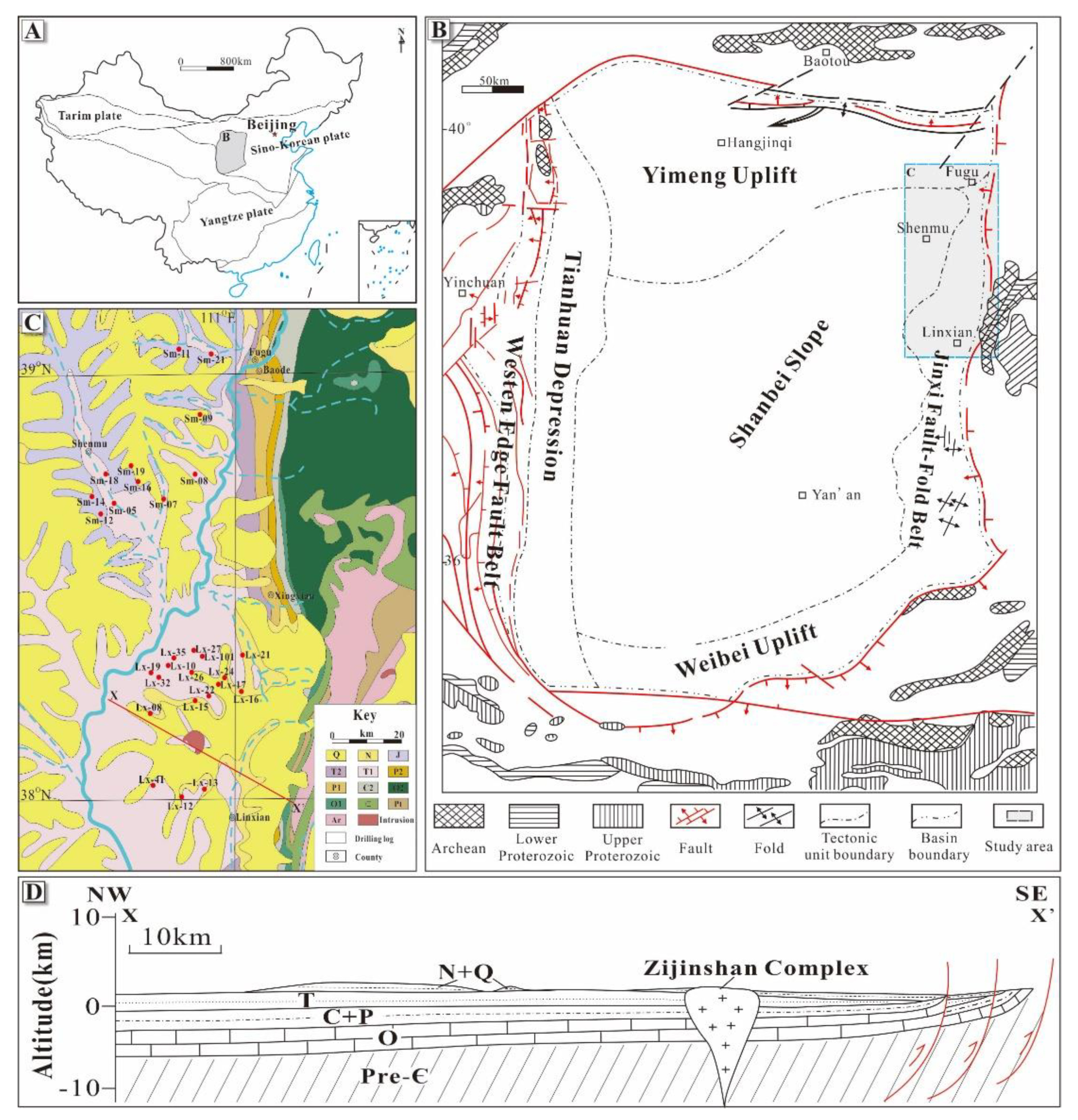

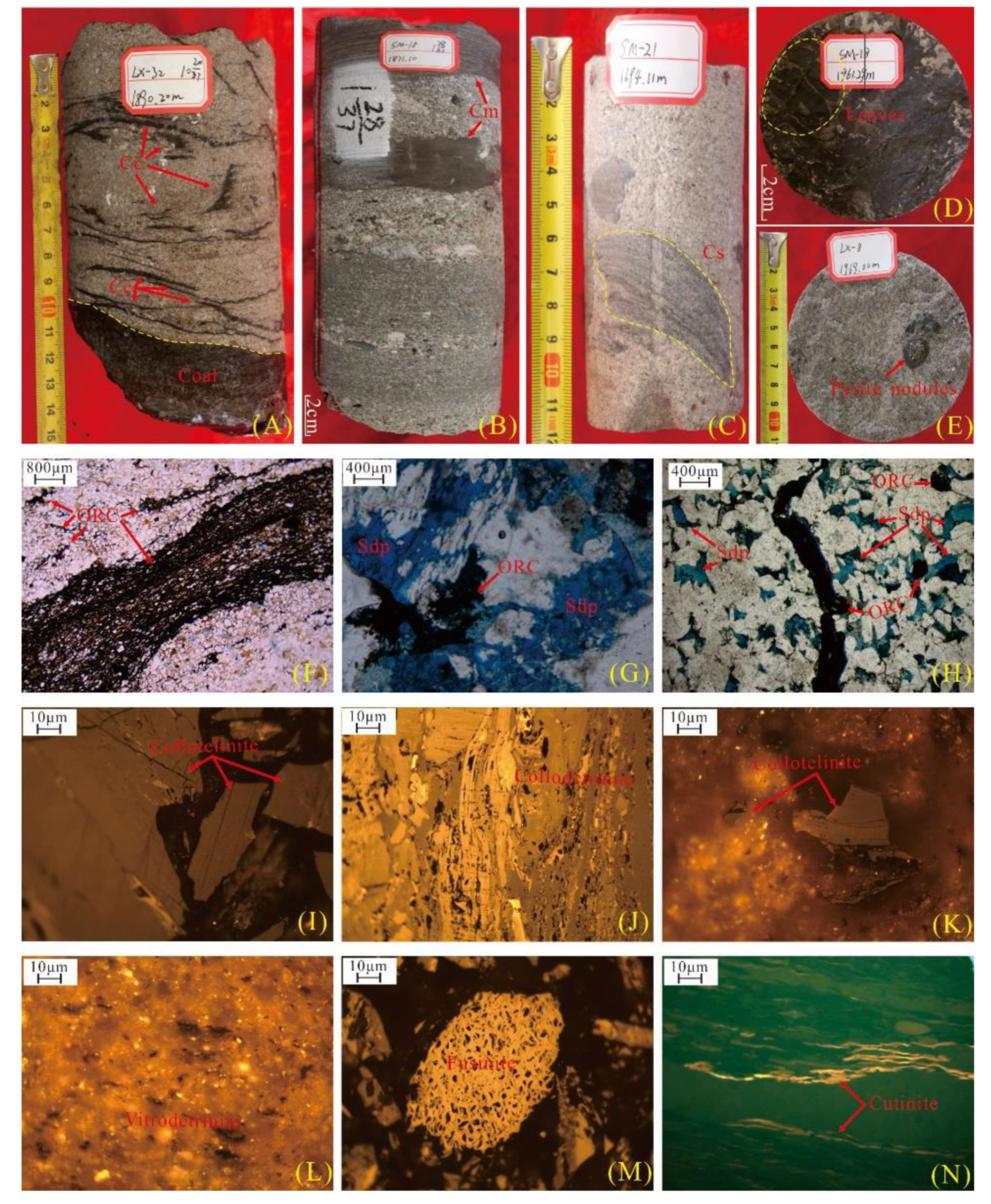
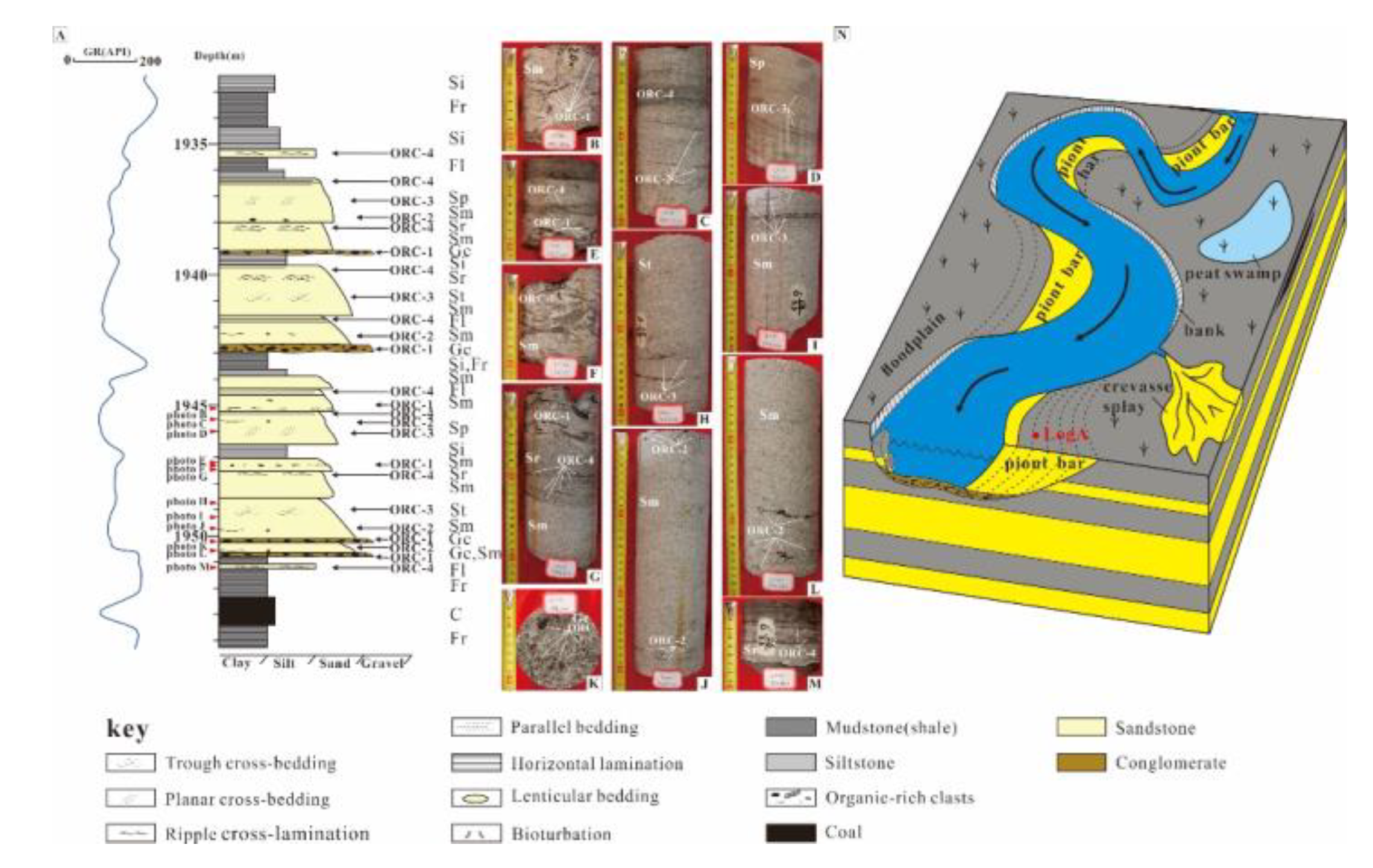
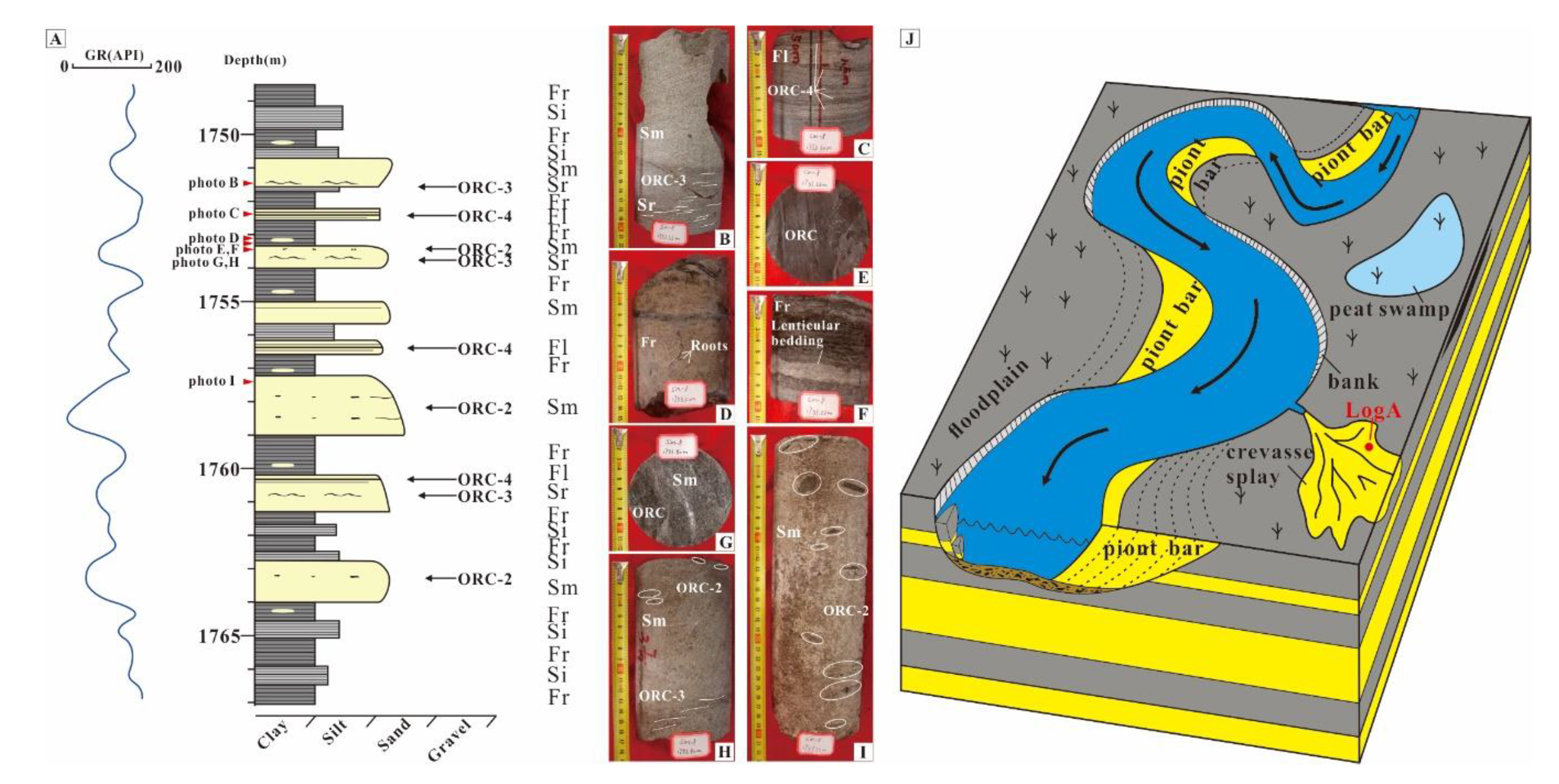

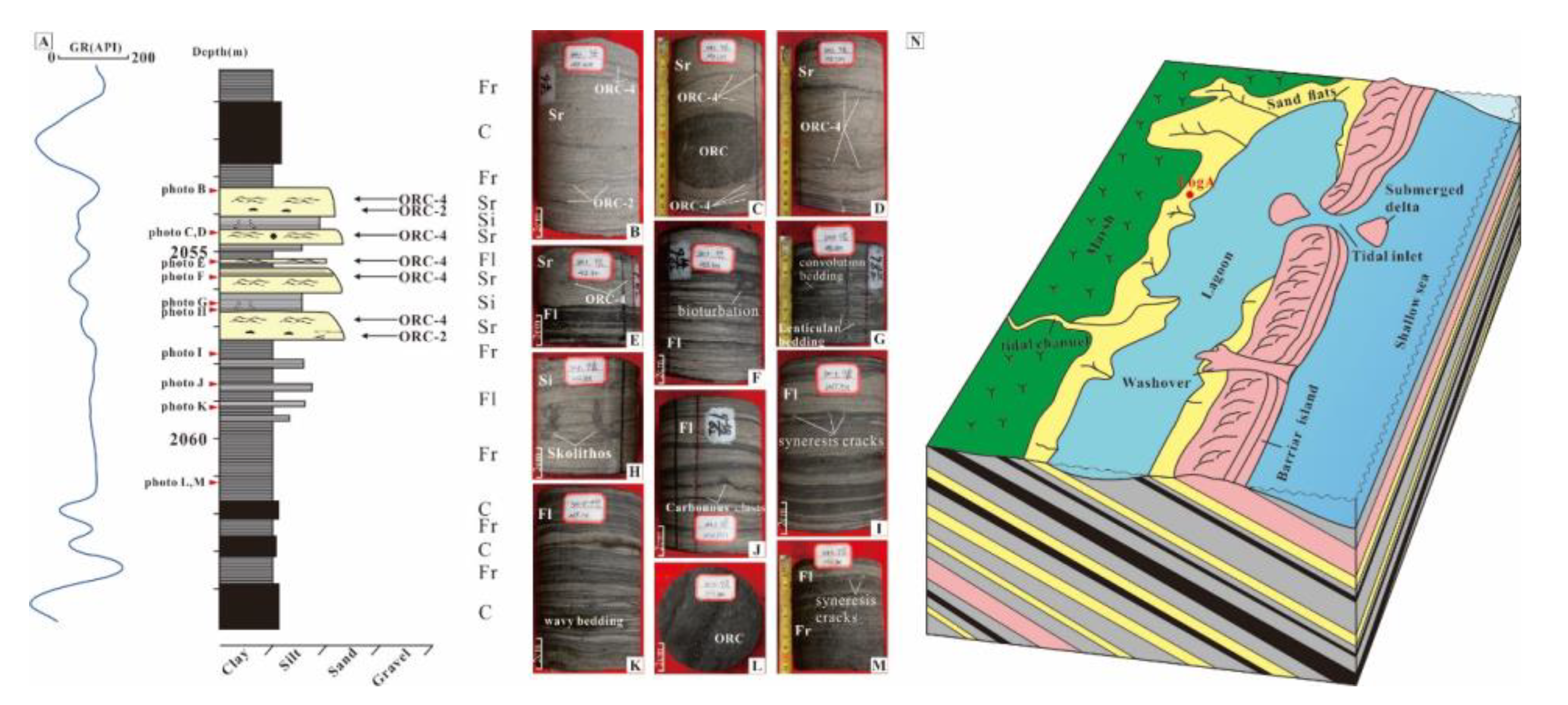
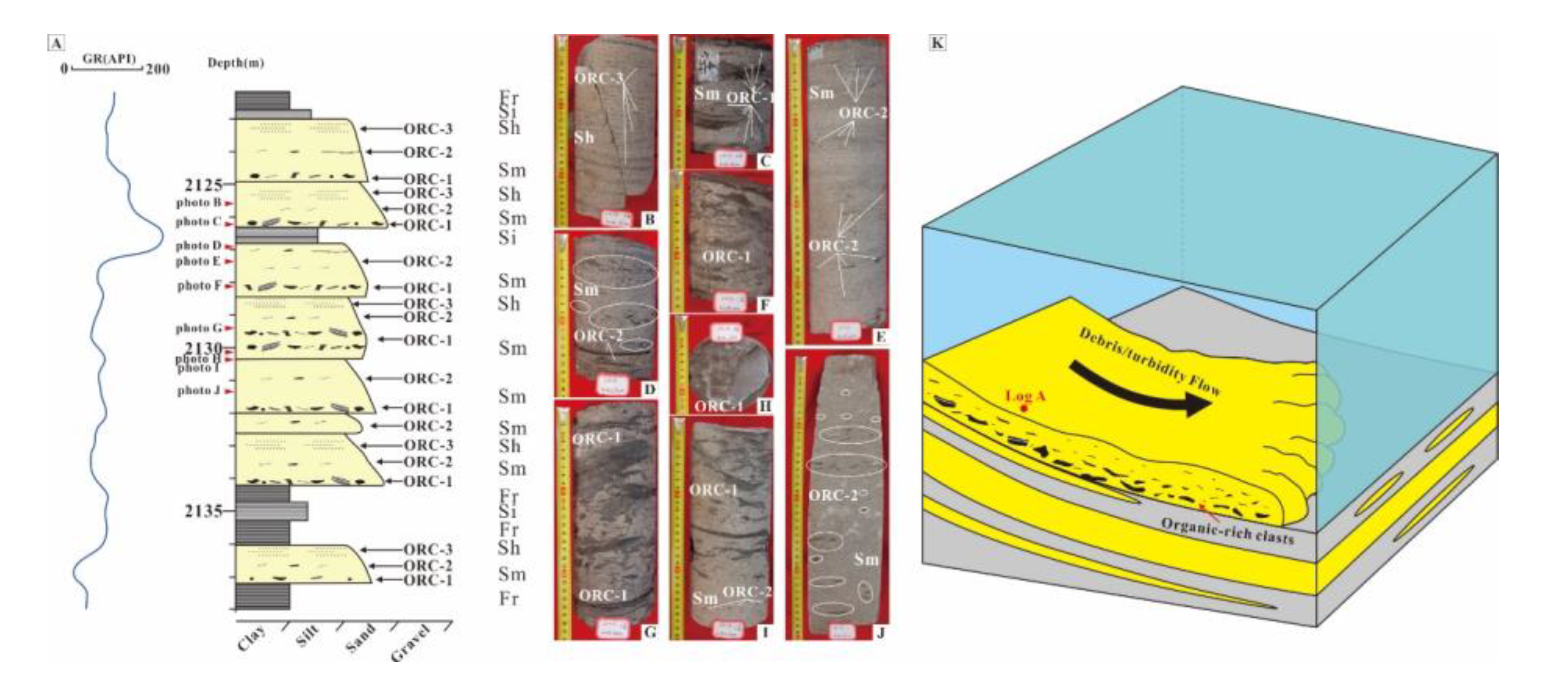
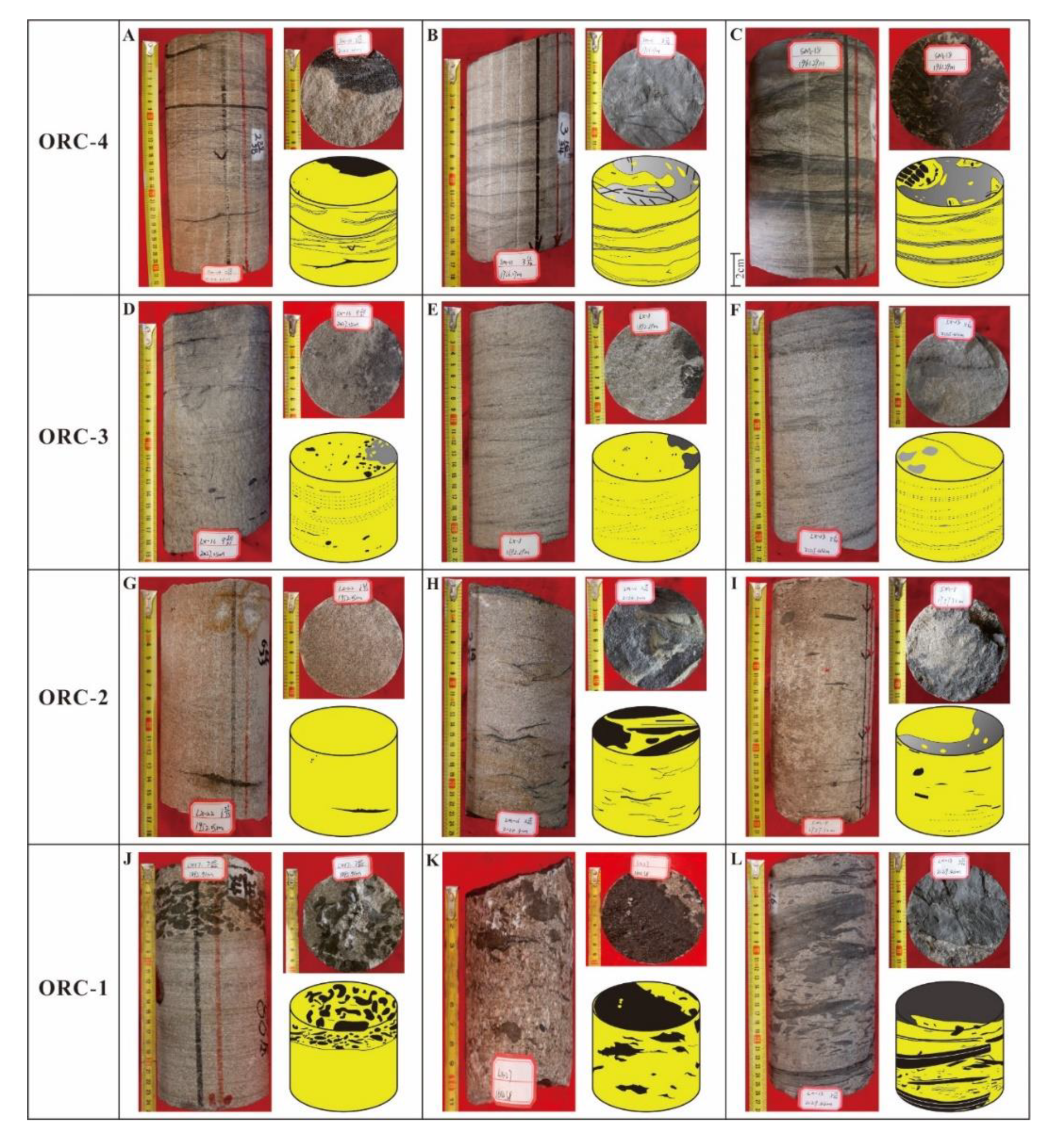
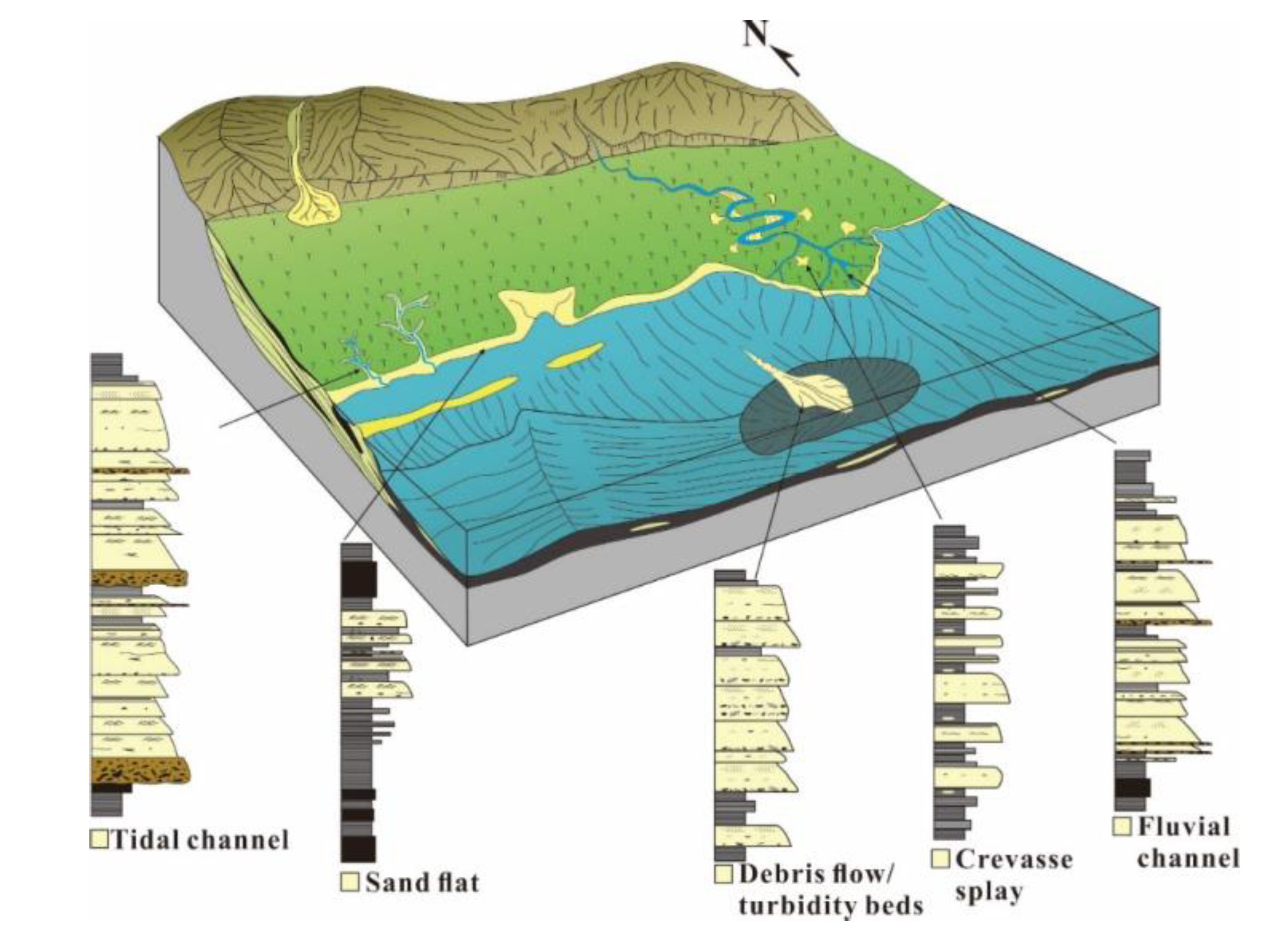
| Facies Code | Lithofacies | Description | Depositional Environment | Example |
|---|---|---|---|---|
| Gm | Matrix-supported conglomerate | Mixed of gravels, sands and detrital clays, mainly gravels, poorly sorted and angular, weak grading, massive bedding, erosional base, thin thickness | Fluvial channel, crevasse splay | 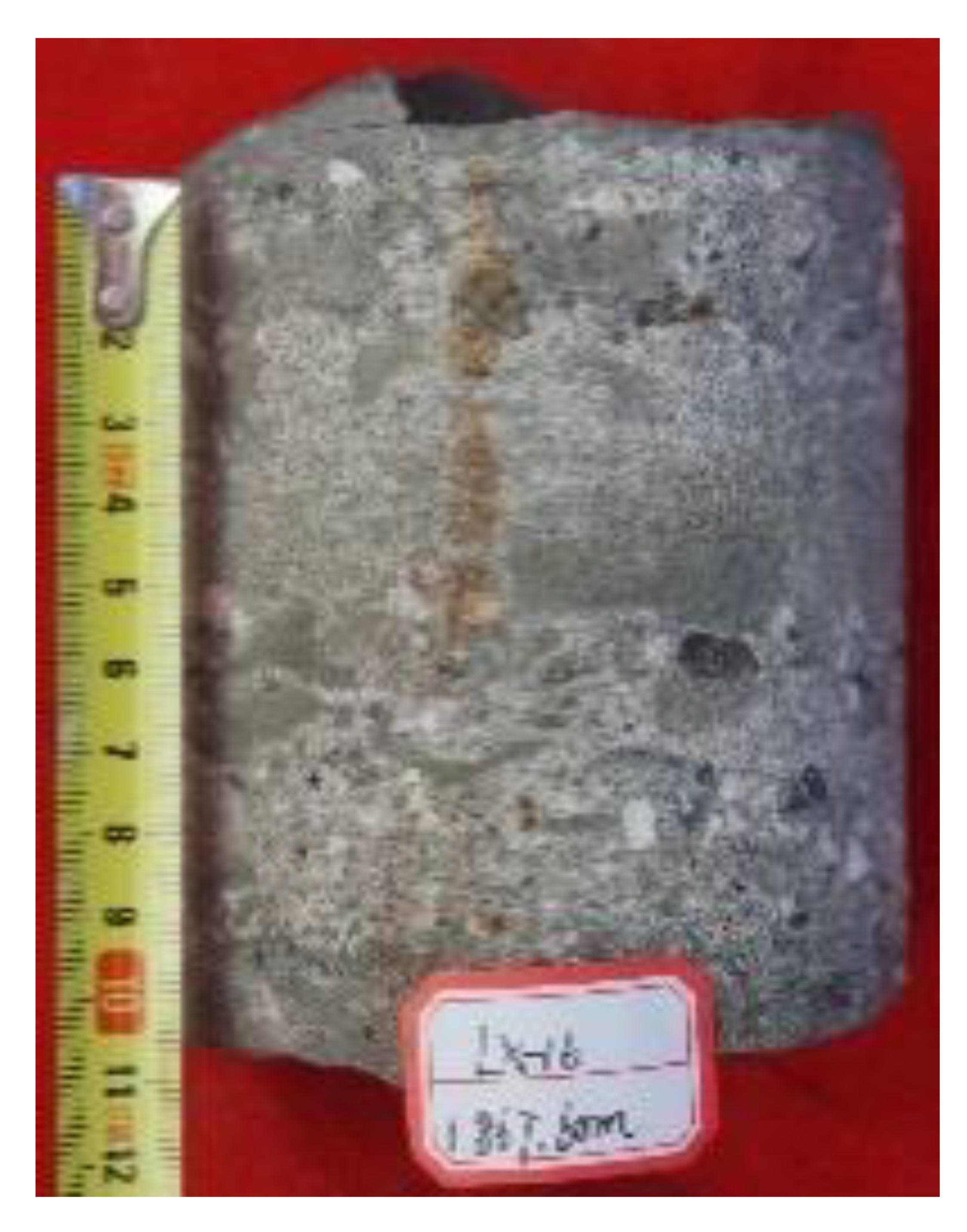 |
| Gc | Clast-supported conglomerate | Mainly gravels, with little matrix, sub-angular to sub-rounded, moderate sorted, graded bedding, erosional base, ranging in thickness from a few centimeters to 20 cm | Fluvial channel, distributary channel, tidal channel |  |
| Sm | Medium- to coarse-grained sandstone | Moderate to well sorted and rounded, massive bedding, structureless, may be pebbly, | Fluvial channel, distributary channel, tidal channel, debris flow deposits, crevasse splay | 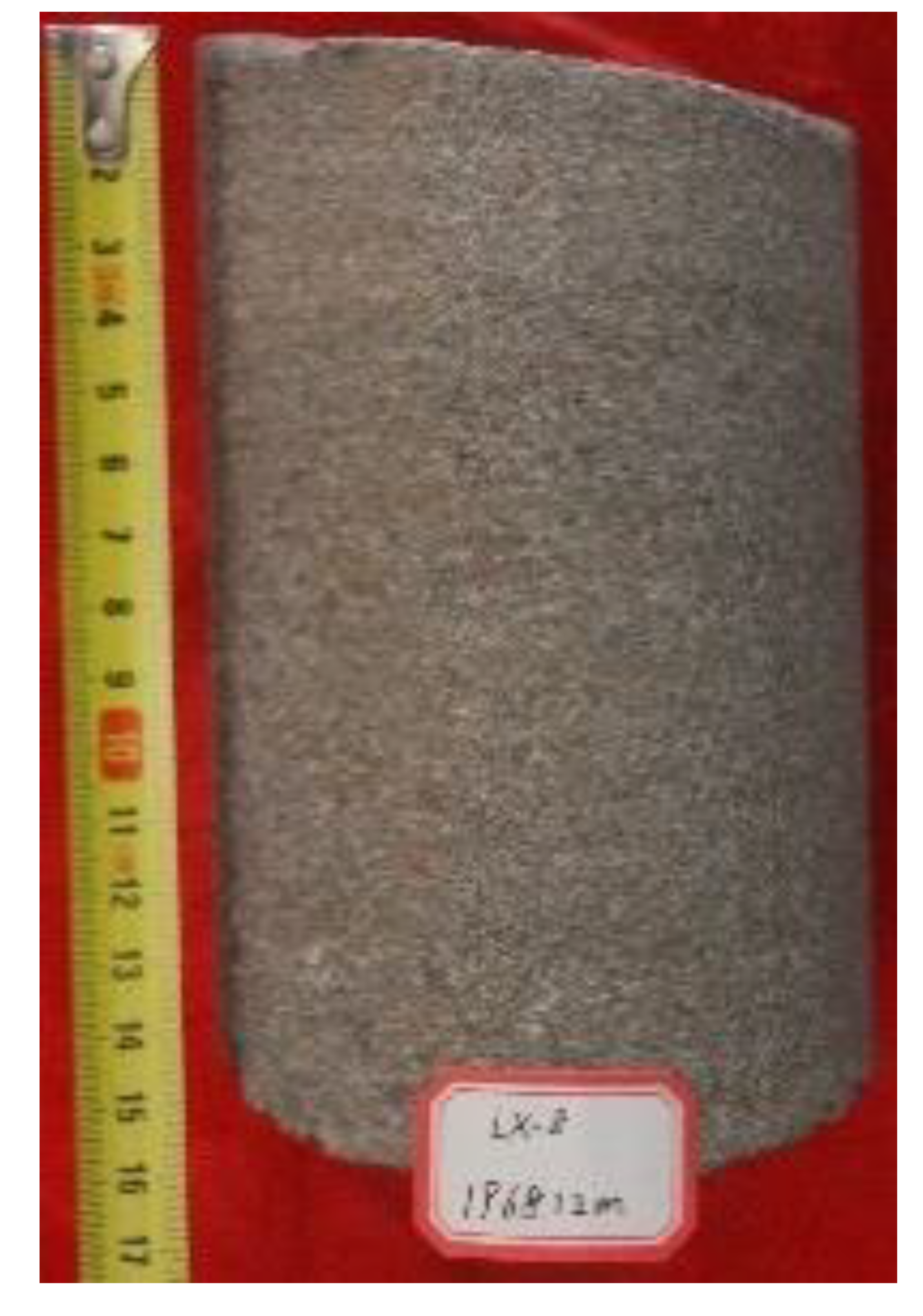 |
| St | Fine- to coarse-grained sandstone | Trough cross-bedding, moderate sorted | Fluvial channel, distributary channel, tidal channel | 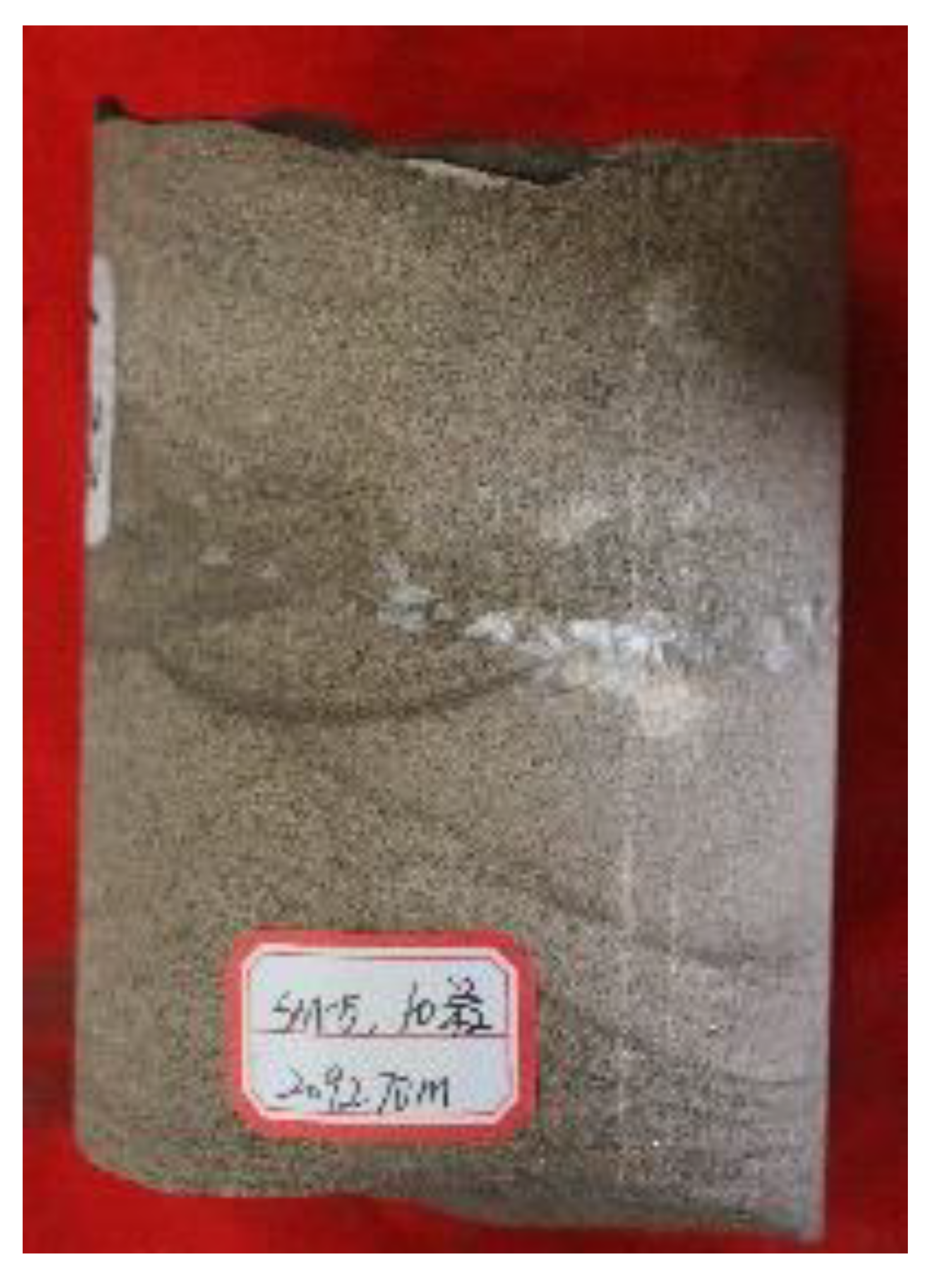 |
| Sp | Fine- to coarse-grained sandstone | Planar cross-bedding, well sorted and rounded | Fluvial channel, distributary channel |  |
| Sr | Very fine- to coarse-grained sandstone | Ripple cross-lamination, moderate sorted | Fluvial channel, distributary channel, tidal channel, crevasse splay, sand flat | 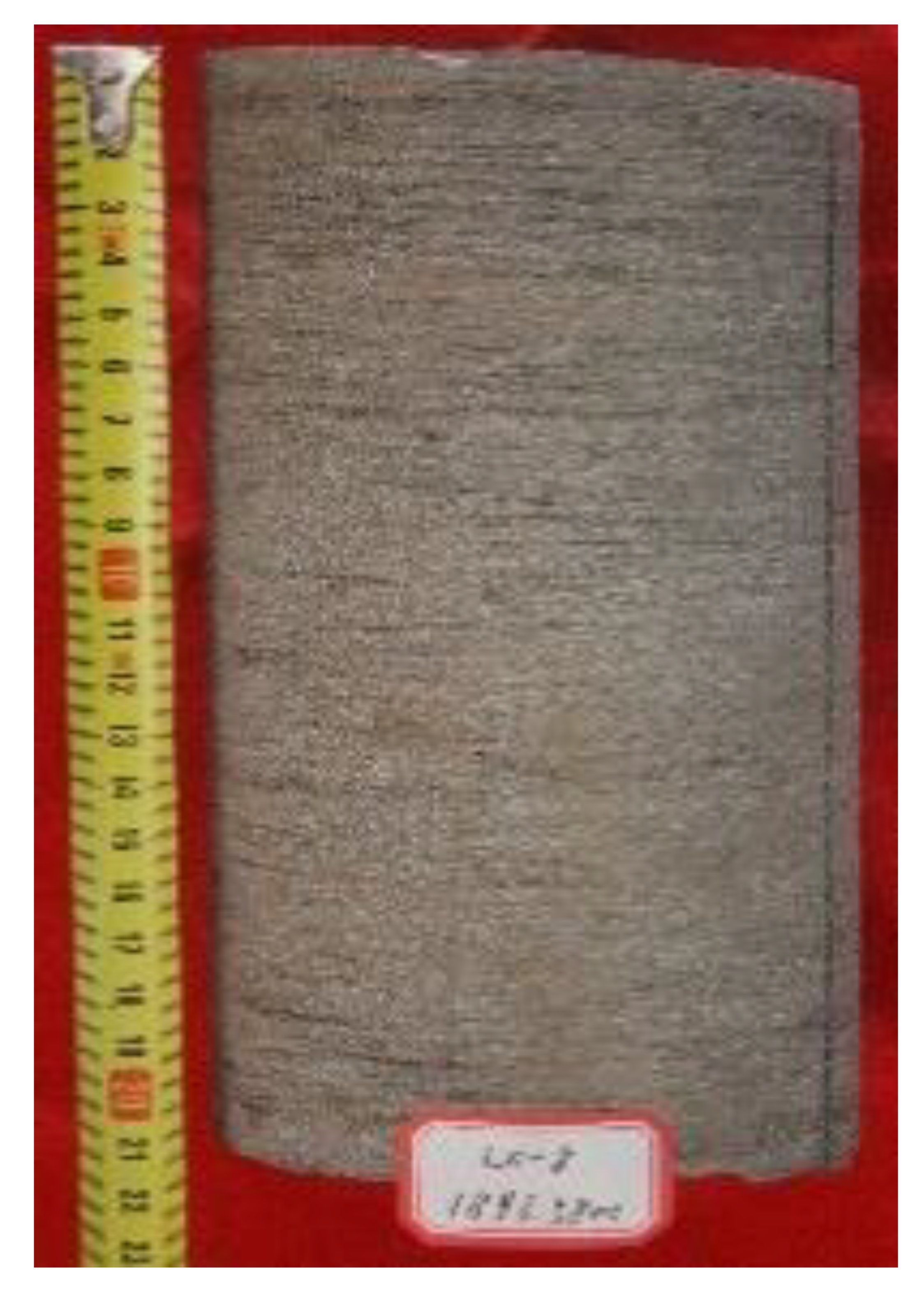 |
| Sh | Fine- to coarse-grained sandstone | Parallel bedding, well sorted and rounded | Fluvial channel, distributary channel, tidal channel, debris flow deposits | 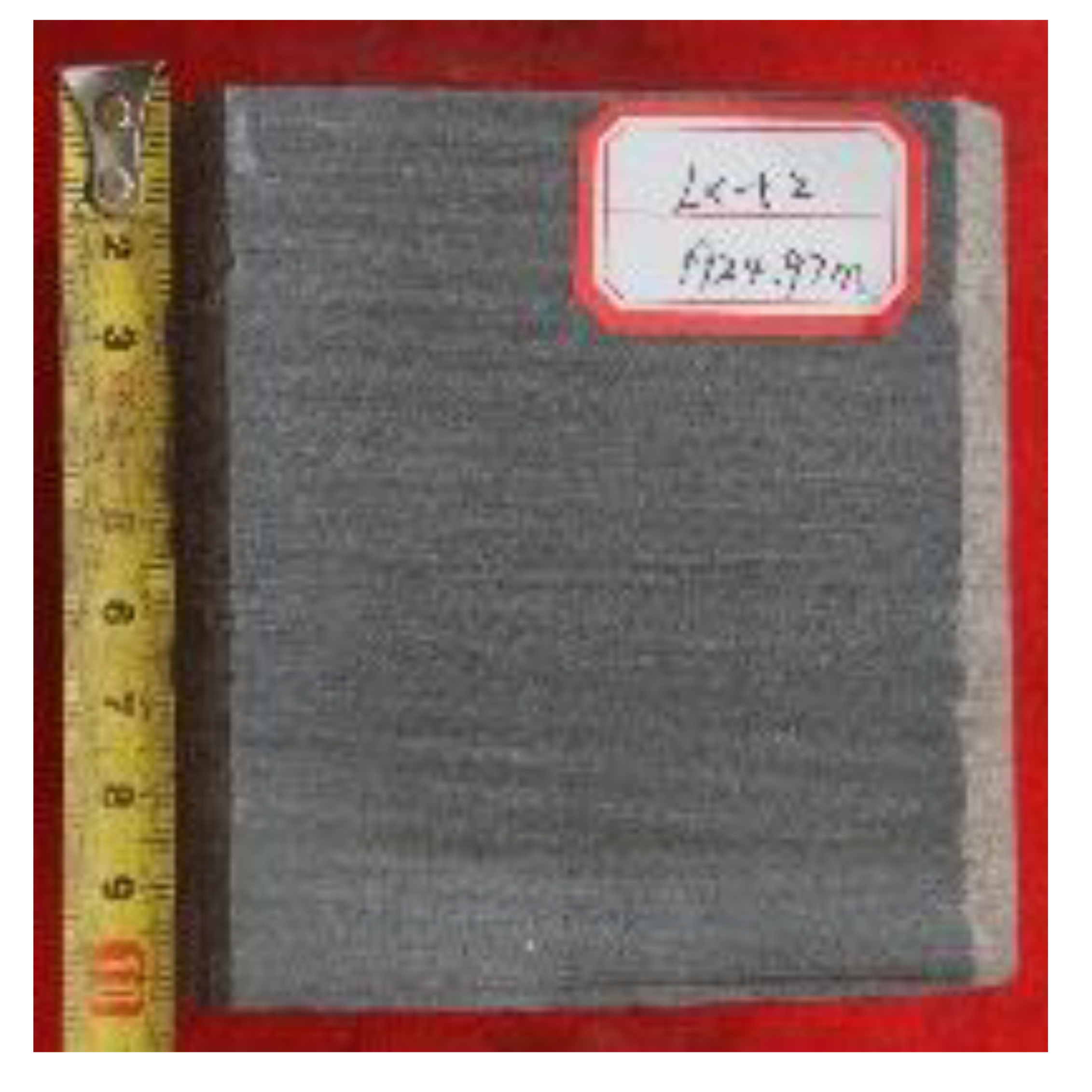 |
| Si | Siltstone and muddy sandstone | Fine lamination, small ripples, well sorted and rounded, with more detrital clays | Abandon channel, flood plain, mud and mixed flat, lagoon, shallow marine deposits | 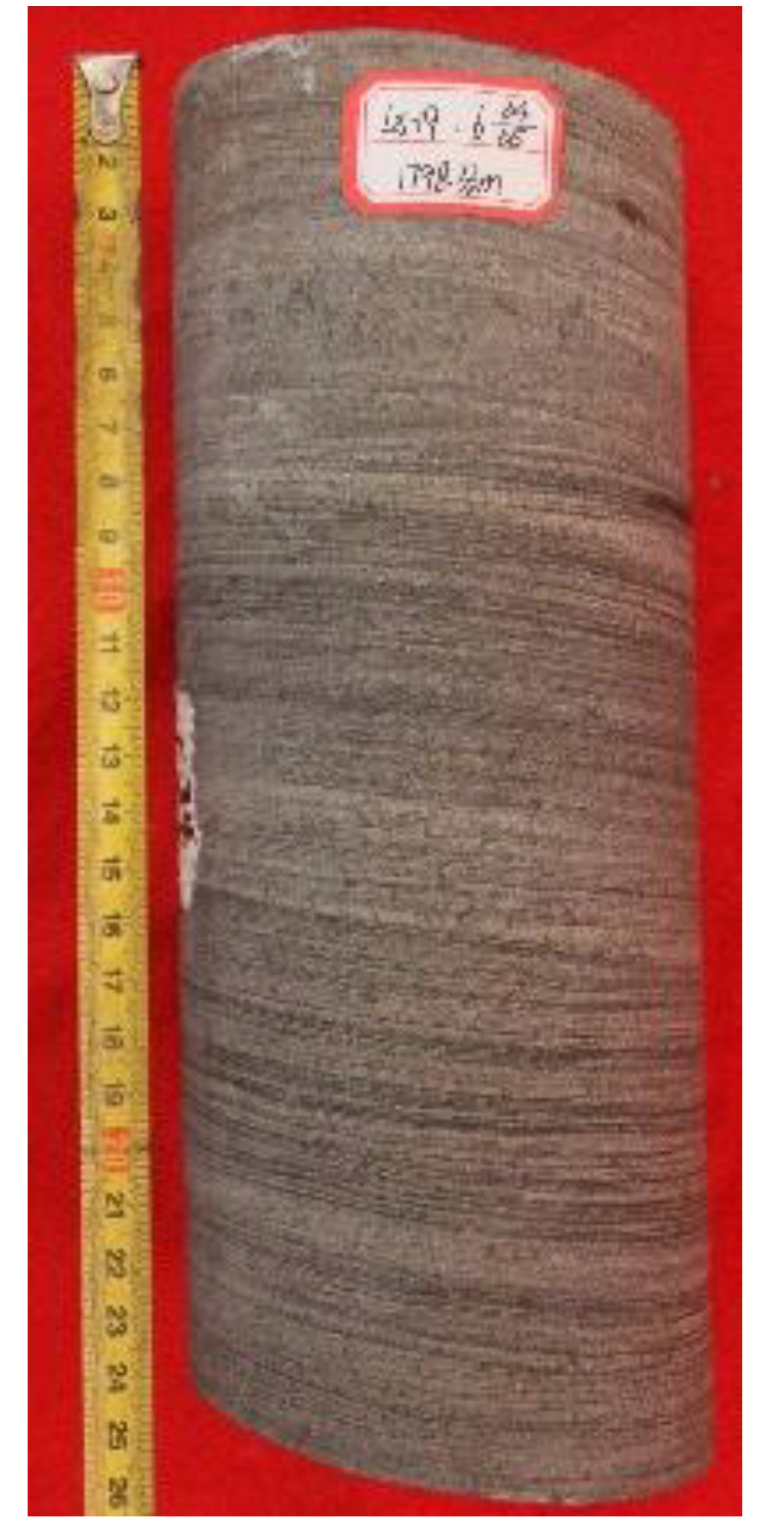 |
| Fl | Sandstone or siltstone interbedded with mudstone | Horizontal lamination, small ripples, convolute bedding, lenticular bedding, bioturbation | Overbank, abandoned channel, waning crevasse splay, mixed flat | 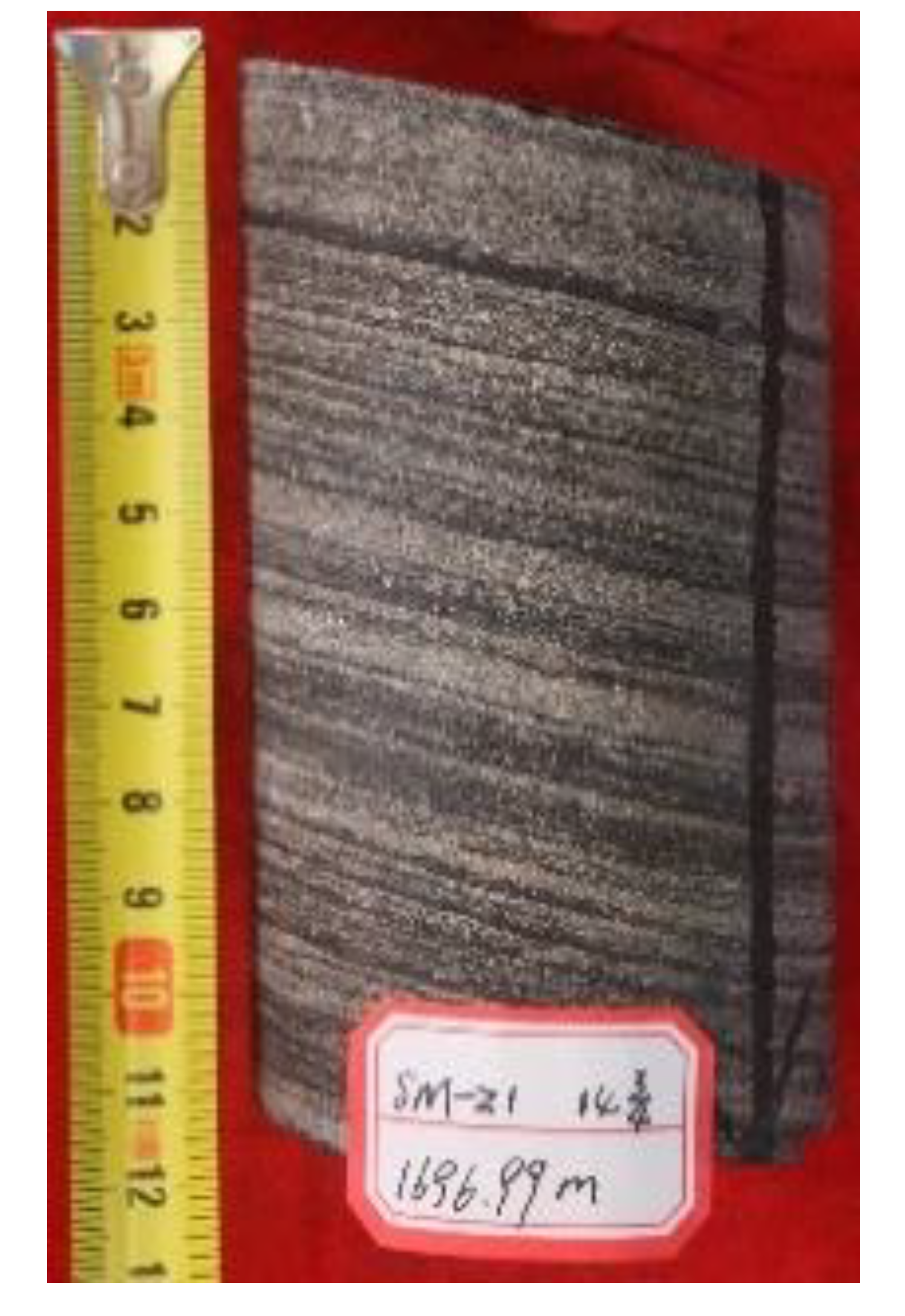 |
| Fr | Mudstone and shale | Horizontal lamination or massive, plant fragments and roots, bioturbation, pyrite nodules | Flood plain, mud flat, lagoon, shallow marine deposits | 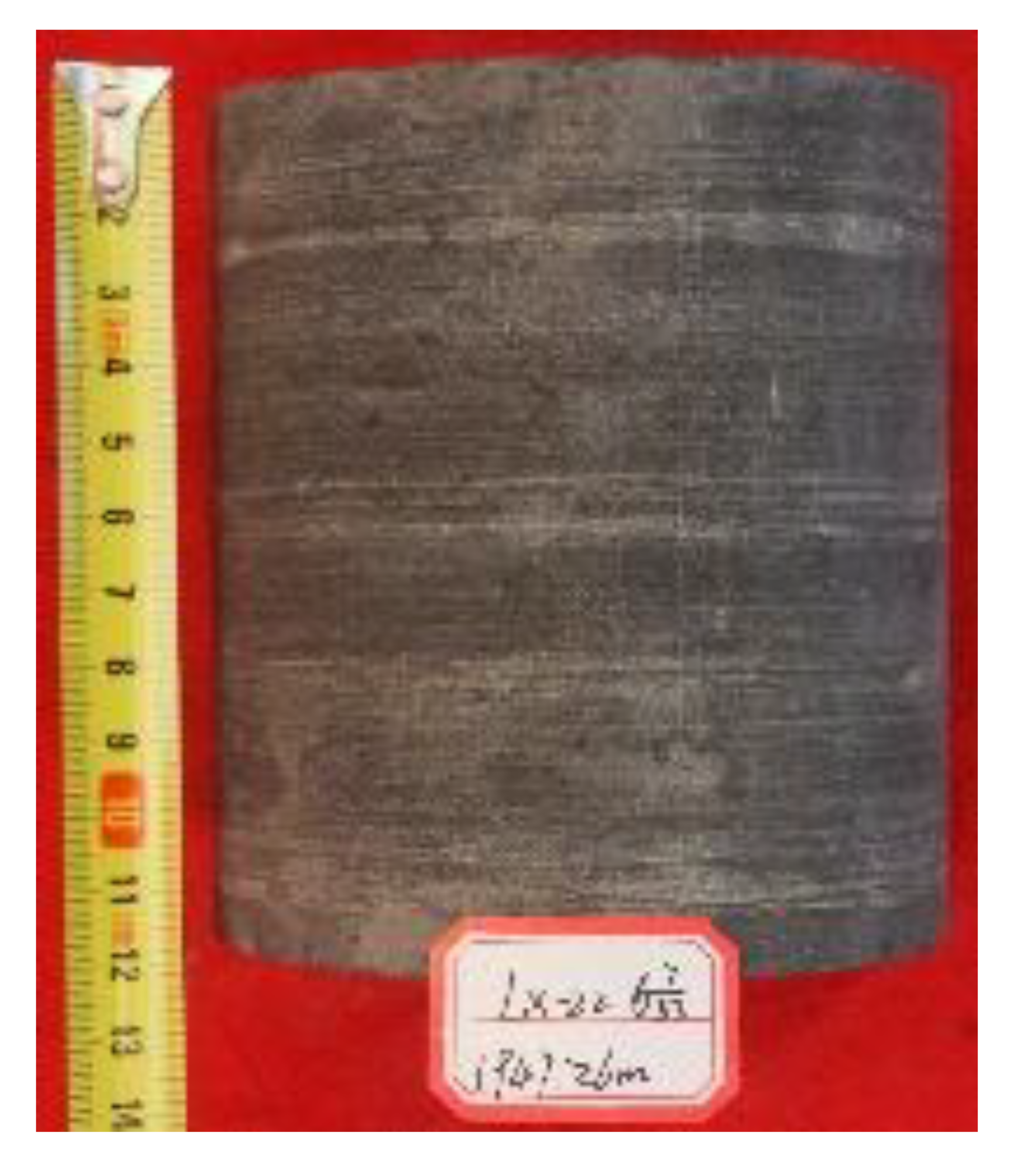 |
| C | Coal and carbonaceous mudstone | Massive, well-developed cleats, plant fragments, containing pyrite nodules | Vegetated swamp deposits, lagoon |  |
| Style Code | Style Name | Features of ORCs in Sediment | Matrix | Transportation Distance | Part of Single Sand Body |
|---|---|---|---|---|---|
| ORC-1 | Diamictic organic-rich clasts | Shape: irregular, lath-shaped, rip-up, angular to sub-rounded Distribution: chaotic distribution Size: particle size varies from granule to cobble | A complete range from gravel to clay, poorly sorted, massive | In-situ or a close distance | Bottom part |
| ORC-2 | Floating organic-rich clasts | Shape: angular to sub-rounded, commonly irregular deformation as wrapped or squeezed Distribution: isolated or scattered, imbrication, long axis of clasts parallel to sub-parallel to bedding Size: pebble to cobble, particle size greater than 1 cm | Medium to coarse-grained, well sorted, Clay-poor,unstratified or structureless | A short distance | Middle and lower part |
| ORC-3 | Loaded lamellar organic-rich clasts | Shape: sub-rounded to rounded, high sphericity Distribution: Distributed at the bottom of the lamina, poor continuity Size: granule to pebble | Fine to coarse-grained, well sorted, Clay-poor, parallel bedding, cross bedding, wavy bedding | A moderate distance | Middle and upper part |
| ORC-4 | Thin interlayer organic-rich clasts | Shape: sub-angular to rounded, flakelet Distribution: in the form of multiple lamellar aggregates, wavy or horizontal, good continuity Size: mainly granule, occasional centimeter-sized clasts are plant fragments (such as stems or leaves) | Very Fine to fine grained, well sorted, clay-rich, lamination | A long distance | Top part |
© 2020 by the authors. Licensee MDPI, Basel, Switzerland. This article is an open access article distributed under the terms and conditions of the Creative Commons Attribution (CC BY) license (http://creativecommons.org/licenses/by/4.0/).
Share and Cite
Yang, G.; Huang, W.; Zhong, J.; Sun, N. Occurrence, Classification and Formation Mechanisms of the Organic-Rich Clasts in the Upper Paleozoic Coal-Bearing Tight Sandstone, Northeastern Margin of the Ordos Basin, China. Energies 2020, 13, 2694. https://doi.org/10.3390/en13112694
Yang G, Huang W, Zhong J, Sun N. Occurrence, Classification and Formation Mechanisms of the Organic-Rich Clasts in the Upper Paleozoic Coal-Bearing Tight Sandstone, Northeastern Margin of the Ordos Basin, China. Energies. 2020; 13(11):2694. https://doi.org/10.3390/en13112694
Chicago/Turabian StyleYang, Guanqun, Wenhui Huang, Jianhua Zhong, and Ningliang Sun. 2020. "Occurrence, Classification and Formation Mechanisms of the Organic-Rich Clasts in the Upper Paleozoic Coal-Bearing Tight Sandstone, Northeastern Margin of the Ordos Basin, China" Energies 13, no. 11: 2694. https://doi.org/10.3390/en13112694
APA StyleYang, G., Huang, W., Zhong, J., & Sun, N. (2020). Occurrence, Classification and Formation Mechanisms of the Organic-Rich Clasts in the Upper Paleozoic Coal-Bearing Tight Sandstone, Northeastern Margin of the Ordos Basin, China. Energies, 13(11), 2694. https://doi.org/10.3390/en13112694



